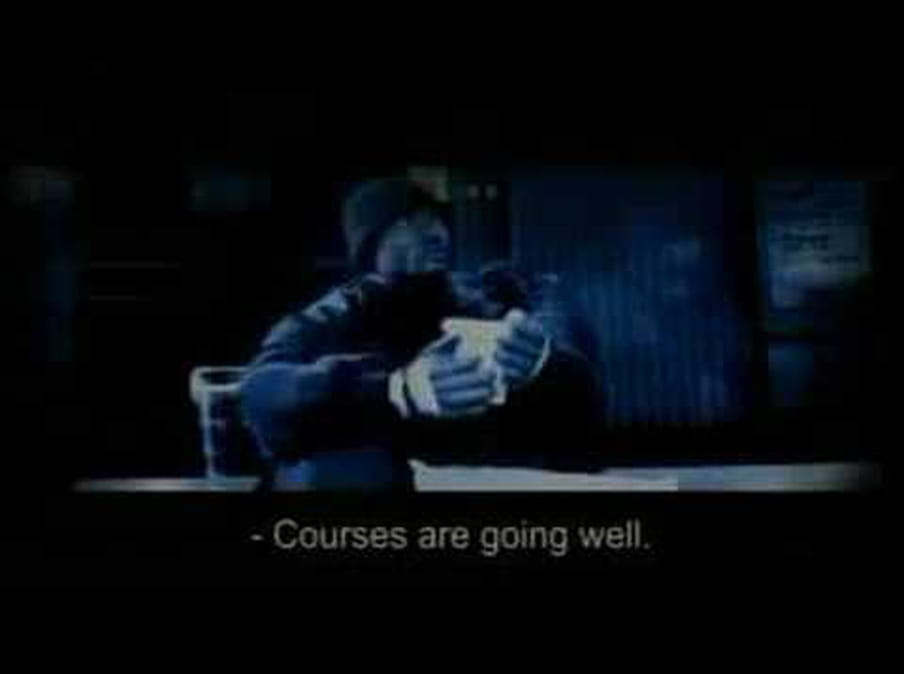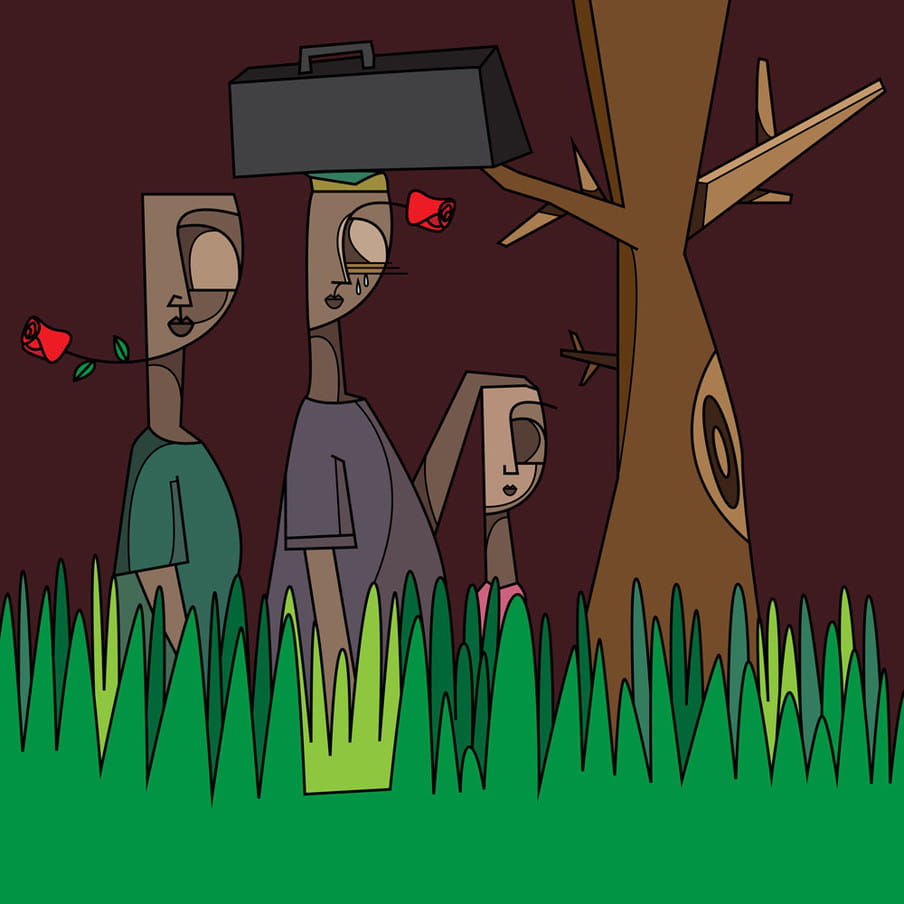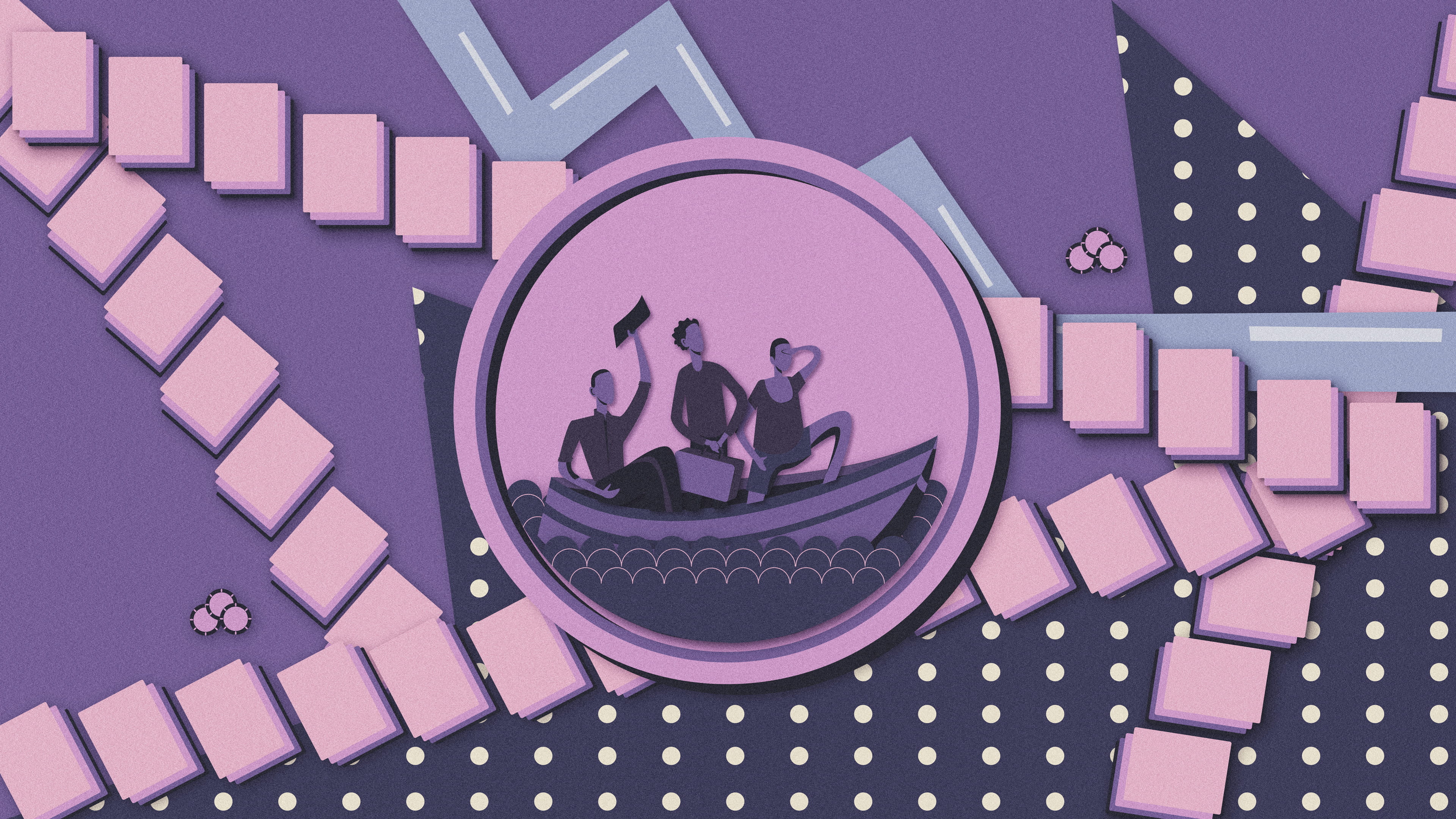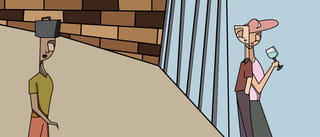David is a born optimist. He’s going to make it in Europe – or, at the very least, he’ll survive there.
He was originally planning to go to Finland until he heard it was really cold. So now it’s Denmark. He’s heard people are nice to black people there.
David (34) is one of many Nigerians who dream of a future in Europe.
I send him a video on WhatsApp. It’s in French with bad English subtitles and starts with a guy about David’s age running at night through the lashing rain to a phone booth to call his father.
“Have you arrived well?” asks his father, clearly relieved.
The man replies: “There’s not problem. My trip was OK. I’m lodging with friends.”
The video intercuts with a shot of him in a sleeping bag under a bridge.
“Have you registered to the university?” his father asks.
“Yeah, courses are going well.”
Another intercut shot: we see the young man begging on the street and running from the police.
The video ends with a message in white capital letters against a black background: “Don’t believe everything you hear. Leaving is not always living.” Signed, the European Union (EU).

David calls me. “What a funny video! Do they really think that’s going to work?” He can hardly speak through bursts of laughter.
Then he gets serious. “Listen, I know very well it won’t be easy. But what kind of prospects do I have here? People like me are determined, that’s just the way it is – we made this decision a while ago. A video like this is really not going to change anybody’s mind.”
The video I sent David is not the only one of its kind. Millions of euros are being spent on campaigns to “raise awareness” about illegal migration. The EU’s reasoning is this: once migrants know just how perilous the journey is, and how difficult life will be in the EU, they’ll probably decide not to come.
But the way David is roaring with laughter raises the question: does this kind of campaign make any sense?
Millions of euros are being spent on campaigns to ‘raise awareness’ about illegal migration.
What picture do African migrants have of getting to and staying in Europe? And more importantly, how did they get that picture?
To find out, I spoke with people in Nigeria (one of the main countries of origin for migrants in Europe): academics, researchers, policymakers, and, of course, with the most important group of all, the would-be migrants themselves.
What I saw was millions of wasted euros and policymakers who know perfectly well they’re throwing away their money.

The anti-migration campaigns
It is tricky to say exactly how much money European countries are putting into awareness-raising campaigns. There isn’t one big pot of money for these campaigns – they’re often part of larger projects. However, as one researcher told me, it’s clear that it’s a “frightening” amount of money.
The EU Emergency Trust Fund for Africa (EUTF) alone spent €16m on awareness raising in just one year.
And then there are the campaigns funded by individual European states. The Italian government put €1.5m into one 2016 project that shared videos of migrants’ testimonies – which were often horrifying – on social media.
The Australians are the leaders in aggressive anti-migration campaigns. In 2014, they launched the NO WAY campaign (tagline: “You will not make Australia home”). The video shows an angry-looking soldier in camouflage fatigues looking straight into the camera: “If you travel to Australia illegally by boat, there is no way you will ever make Australia home.”
However, no European country would be caught stating explicitly that they are running a campaign against migration. Europe’s goal is “safe and informed migration”. According to the EU, the information in the campaigns is “factual ” and the aim is “neither [to] deter migrants from setting out for Europe nor create pull factors for them to do so”. The idea is to provide “a realistic picture” that migrants can use to make choices.
A few of the campaign titles show this attempt to impartially inform:
- Aware Migrants
- Know the Facts
- Look Before you Leave
- Migration Enlightenment Project
TV and radio ads, stage shows, posters, soap series, print ads, songs, performances by local stars – you name it, Europe funds it. Denmark, for example, placed ads in Lebanese newspapers about new, stricter regulations on migration. Norway started a Facebook page with the same aim. And Germany started the campaign #RumoursAboutGermany. Its website features articles such as “Seven big lies about human traffickers” (lie number one: “The ship you’ll cross on is very big; it even has a pool and a cinema.”).
The underlying idea is always: migrants don’t really know what they’re getting into, and if they only knew what dismal fate awaited them, they wouldn’t go to Europe.
But is that really true?
Nigerian migrants see Europe as a utopia
“My picture when I arrive … ” says Ebi (32), with a faraway look in his eyes. He’s already tried to get a visa twice, once for Germany and once for Canada, but he’s still here, in Oyo State, Nigeria. “For me, it’s a place of opportunities. A place where I can be who I want to be.”
I spoke with 15 Nigerian would-be migrants while writing this article. All of them have tried to get to Europe; so far none of them have succeeded.
Without exception, they see the EU as a utopia. Yes, they’re wearing rose-tinted glasses, but they’re not entirely wrong. Words that keep popping up are “opportunities”, “infrastructure”, “a simple life”. They also use “green” a lot – green spaces where you can relax. And the government takes care of its citizens.
“Over there, dreams come true more easily than here,” says Onimisi (39) from Ibadan, who has tried to reach Germany and the US.
‘No one wants to take a risk like this, but sometimes they think, "I don’t see any other way out, I see no other hope. Maybe I’ll try it, maybe I’ll get lucky and make it."’
“Life is easier over there,” says John (47) from Benin City, whose destination was Luxembourg both times. “There’s good infrastructure and access to healthcare. The cheapest thing there is food – and here, it’s hard to eat three times a day.”
Most importantly, you earn more. Flora (29), now preparing for her second attempt to get to Italy, says: “I graduated six years ago, and I’ve only found volunteer work here. There are no jobs. Even doing manual labour in Italy, or babysitting, still earns much more than anything I could find here.”
And no, they don’t expect that life in the EU will be easy. Onimisi says: “It won’t be a bed of roses. But it will be better than in Nigeria. Here you can’t count on electricity, and there you can. Here the roads aren’t paved, there they are. Here there aren’t any good hospitals, and there are plenty over there.”
They all know overland travel is perilous. “Yes, of course, we see the news too!” John says, throwing up his hands. “I see how people are locked up in Libya, how they drown in the Mediterranean sea. They use tiny balloon boats. And people climb into them – it’s like a suicide mission! I would never do that – my life is worth more than that.”
David, who was caught three times on his way to Scandinavia, agrees. “The risks are gigantic! You can die without anybody knowing. I have friends who died on the road. I have friends I haven’t heard from since.”
Yet he understands the choice. “We’re suffering here. We are really suffering. Many people haven’t eaten yet today. No one wants to take a risk like this, but sometimes they think, ‘I don’t see any other way out, I see no other hope. Maybe I’ll try it, maybe I’ll get lucky and make it.’ People are desperate.”

How do migrants get such a rose-tinted view of Europe?
“I love American high school movies,” says Ebi. “That’s how I got fascinated by white people’s lives: they have such an easy existence.”
When I ask these hopefuls what their knowledge of Europe is based on, it quickly becomes clear that American films and music are the primary sources of information.
As Ominisi puts it: “You watch all those films and video clips and you think: ‘Ah, OK, the good things in life are there, not here.’”
They also search the internet (every one of them says: “I have done my research”). They follow the news and read blogs. David ask me: “Did you hear about that Spiderman from Mali who saved a baby from a building in France? He has a residence permit now! Once I’m in Denmark, I’m only going to look up at buildings.”
And then there’s their Facebook feeds. Everyone’s most important source of information is their own network. Everyone has a “brother” – who can be a third cousin related through marriage on their mother’s side – in Europe.
Uche (40), who tried once to get to Germany, says: “I see the kinds of photos they post on Facebook and then I think, ‘Oooh, I want to be there too. They drive big cars. They have green spaces where they can relax. They have light 24 hours a day! It looks like the American movies we watch.”
Sometimes, the contact is more direct. William has a nephew in Cyprus. “He called me and said, ‘I’ve been here six months and I haven’t seen a single traffic accident!’ Here in my city, we bury someone every weekend.”
What about the negative images of Europe?
Hearing their romanticised stories, you can understand that the EU would like to adjust this picture. Of course there are nice green parks in Europe, but the idea that as an illegal immigrant you can relax in one all day long while your needs are being met by the government isn’t terribly realistic.
Don’t they encounter any negative images about Europe or living illegally?
Yes. And this is where it gets really interesting.
At the University of Ibadan, I meet Ayo Ojebode, head of the Communication and Language Arts department. He’s an empathetic, cheerful man, whose background in communications got him interested in how prospective Nigerian migrants inform their decisions.
His conclusions build on the work of the US American social psychologist Leon Festinger, who came up with his theory of “cognitive consonance” in the 1950s. Consciously or unconsciously, people are constantly maintaining their world views, their ideas and their opinions, even when the evidence overwhelmingly points to the contrary. We do so, Festinger concluded, to avoid “cognitive dissonance” – a kind of psychological unease that we experience if we encounter images, facts or ideas that conflict with our worldview.
Consciously or unconsciously, people are constantly maintaining their world views, their ideas and their opinions, even when the evidence overwhelmingly points to the contrary.
“We prefer to discard everything that is inconsistent with our existing views,” says Ojebode. “You can see it in political debates, in religious circles, and thus with migrants too.”
Take Prison Break, which is enormously popular in Nigeria. “That’s a very violent American series, where life is a struggle,” says Ojebode. “But that’s not what the young people in our studies take from it. They select only the pictures that reinforce their positive image of the US: good roads, electricity, trees, blue jeans, tattoos.”
The rest goes into the mental rubbish bin.
How to put negative images on the mental garbage heap
Migrants have several ways of throwing any negative ideas about the west on a mental garbage heap.
Uche, for example, thinks he can get started in Europe with someone else’s passport or work permit, because, as he says jokingly, “You think we all look alike!” I tell him that he’ll be deported if the police find out. “Sure I will, if they find out. But there’s a chance they won’t.”
I heard this rationale time after time from the aspirant migrants: nothing bad will happen to me. One popular Nigerian catchphrase is, “That is not my portion.”
It’s a bit like smoking: you know it’s not good for you, but you don’t think you’ll get lung cancer. The gory photos on the cigarette packets can go on your mental garbage heap because they have nothing to do with you.
Migrants have several ways of throwing any negative ideas about the west on to a mental garbage heap.
Religion, an ever-present force in this very devout country, reinforces this reasoning: if you just pray hard enough, God will make sure you don’t end up at the bottom of the Mediterranean. Flora says: “Every day I pray for a miracle. I pray that God says, ‘I’ll help this child because she’s done good things for others and because she won’t be selfish once she gets to Europe.’”
John had his priest lead a special worship session on the eve of his first attempted departure (which failed, costing him thousands of euros). A participant in one of Ojebode’s studies even held a three-day-long vigil entitled "Your Visa Shall Appear".
Besides clutching this blind faith, prospective migrants actively keep negative images at a distance, mentally turning the page when they see photos that blight their pretty picture of Europe. In one of his studies, Ojebode showed “failed migrants” photos of the Syrian three-year-old Aylan Kurdi’s body washed up on the beach. One participant said: “I always stay away from pictures like this … they don’t help me make my dream or ambition come true. If I see photos like this, it’s an accident, and I click them away immediately.”
The same goes for negative stories. David tells me he spoke with a returned migrant who tried to persuade him not to go. “Then I think, ‘he’s just trying to discourage me’. I shake it off and forget about it.”
Then there’s a tactic that Ojebode calls “rebackgrounding”. Migrants give the negative pictures a new context, a new background. A new context for the drowned body of little Aylan, for example, is that Aylan is the rare exception to the many who survived and made it to Europe. Or that Aylan may have suffered, but compared to all the suffering in Africa, that’s irrelevant. “There is so much suffering here,” says David. “Yeah, we could die along the way – but here we’ll die for sure.”

If the diaspora spoke about their difficulties, no one back home would believe them
The hopefuls are not the only ones who distort information. Those who make it to Europe do the same; they select what information they share with those back home.
Ojebode explains: “The diaspora tell people back home about food, security, electricity – but they say nothing about the problems in Europe, that they live from one badly paid job to another, running away from the police. It’s embarrassing to admit you have a hard life there, or that you might well have made a mistake in leaving home.”
Uche agrees: “Nobody will say, ‘I’m having a hard time’. At most, they might say ‘I’m OK’.”
But, says Uche, “OK” is a loaded word, meaning something like “I have hope that it’ll get better”.
The migrants I speak with all have only a vague idea of exactly what their brothers in Europe are doing. They have “businesses” or are “making money” – that’s all they know. Uche thinks hard when I ask him about the jobs of two of his friends in England. “I think one is a musician … and one is a kind of janitor. But they’re OK.”
Even if the diaspora were to talk about their difficult lives, no one would believe them. It would produce too much cognitive dissonance.
Uche says: “I would abuse you if you would say to me it is hard in the west! Nobody would believe you! How can you be in the west and you’re not OK?”
Ebi has a brother who left for Canada five years ago. “He almost never calls, he says he doesn’t have the money to call. What kind of nonsense is that? We have nothing here, but we buy credit to call him! He tells me life is hard there, but I don’t believe a word of it! I think he just doesn’t want to help us. I refuse to believe he’s so broke he can’t even phone us.”
That’s something else I hear often: that the people who’ve left are not good at staying in touch. Instead of seeing it as proof that life in Europe is hard – and that it’s difficult to admit – aspiring migrants see it as proof of just the opposite.
As Ebi puts it: “They don’t want us to know how good they have it there. They’re afraid that we’ll come too, or that we’ll beg from them.”
William (47), who tried to reach Britain twice, says the same thing: “They don’t ring us up because they’re afraid we’ll ask them for money. So if you make it over there, it’s better not to let people know.”
And this way of thinking is familiar to John too: “My uncle has lived in Britain for a long time. He’s a big man there, he has a business and a house. But he’s forgotten everyone back home. He doesn’t contact us. That’s the thing with people who go away: they don’t look back.”
The EU knows its campaigns aren’t working. So what is it doing?
Let’s come back to those EU awareness campaigns. After speaking to so many migrants, I’ll put it bluntly: the campaigns don’t work.
“I know what they’re trying to do with these videos,” says David. “They don’t want us to come.” As soon as the EU logo appears in the video, the would-be migrants mentally discard the information.
Even if the migrants did see the EU as a reliable source of information, they still would distort or ignore anything that doesn’t fit their romantic notions of Europe.
I’m not the first to observe this, of course. In the last few years, a variety of studies and reports have been published, and they all come to the same conclusion: these campaigns have no effect. As one research firm put it in a study commissioned by the Institute of Development Studies: “There is very little evidence on the impact and effectiveness of these campaigns and anecdotal evidence suggests that they have limited, if any, effect on migrants’ decisions to leave.”
If we know they don’t work, then why is the EU pouring so many millions of euros into these campaigns?
The data from the Mixed Migration Centre, which holds in-depth interviews with ten thousand migrants a year, shows that less than 5% of west African migrants use information from posters or flyers before they leave. Less than 4% visit specialised websites, and just 0.6% make decisions based on information from authorities.
If we know this, then why are we pouring so many millions of euros into these campaigns?
The short answer is that we feel a responsibility to do something. The EU’s harsh border management leaves dangerous routes as the only option for getting to Europe. This comes with a certain responsibility, which once again can be compared with smoking: even if putting those awful photos on the packets is pointless, not providing information about such a dangerous product is not an option either.
A migration researcher tells me that at an international conference, they spent two days discussing the shortcomings of awareness-raising campaigns, fully aware that there is no point in telling people how treacherous the journey is. “Then a member of the EU delegation says with a straight face in his closing remarks that we’re doing things right with these campaigns. That’s pretty absurd. But European leaders feel like they still have to do something.”
This predicament can also be seen with the main body that makes these campaigns, the International Organization for Migration (IOM). The halls of their Lagos office display the supposedly deterrent posters: CAUGHT, with a drawing of a black man being handcuffed by four white police officers; END GAME, with a drawing of three men drowning in a stormy sea.
“We’ve been running campaigns to frighten migrants for years,” says Abrham Tamrat, head of migration management with the IOM in Nigeria. “But if you say ‘this is dangerous’, it keeps the hope alive that there is a chance they will make it.”
“Migrants are perfectly well aware of the dangers. They know what the risks are.” Women who make plans to migrate often go on the pill beforehand, knowing they may be raped underway. “We have to focus on changing behaviour,” says Tamrat. “How can you say no to the risks?”

Sometimes, staying is worse than leaving
The IOM is now experimenting with some new methods. In Niger, they’re having migrants make their own videos, which don’t have an IOM or EU logo, so they can distribute them in their own networks. In Nigeria, they’re trying to involve the diaspora in the campaigns. And soon they’ll start trials of community dialogues – an approach that had good results in anti-HIV campaigns.
Migration researcher Bram Frouws of the Mixed Migration Centre thinks that the campaigns should focus on a safe journey. “If you take the journey, do it right. What can you do if you have problems underway? What are your rights? And what are the legal ways to get into Europe?”
Because, says Frouws, no matter how dangerous the journey, “sometimes staying is simply worse than migrating”.
David thinks so too. “Look at the poverty here, look at the desperation. We’ll keep coming, videos or no videos.”
And even if the odd would-be migrant decides to stay after seeing an END GAME poster, it’s a lot of money per migrant who changes their mind. “It’s a waste of money,” David says.
Of course, only a relatively small portion of European development budgets goes to awareness-raising campaigns. But would-be migrants don’t care what percentage it is. Those millions of euros, too, could be better spent.
The best suggestion comes from Uche: “Why doesn’t the EU pay people not to come?” He laughs. “They should do that, then we will stay here!”
This article first appeared on De Correspondent. It was translated from the Dutch by Anne Hodgkinson.
Dig deeper
 10 questions that explain the European Union’s migration policy
Ahead of a reported series tracking how millions of euros allocated by the EU to "tackle the root causes of migration" are spent, I go behind the headlines and the rhetoric to lay out exactly what Europe’s migration policy is.
10 questions that explain the European Union’s migration policy
Ahead of a reported series tracking how millions of euros allocated by the EU to "tackle the root causes of migration" are spent, I go behind the headlines and the rhetoric to lay out exactly what Europe’s migration policy is.


